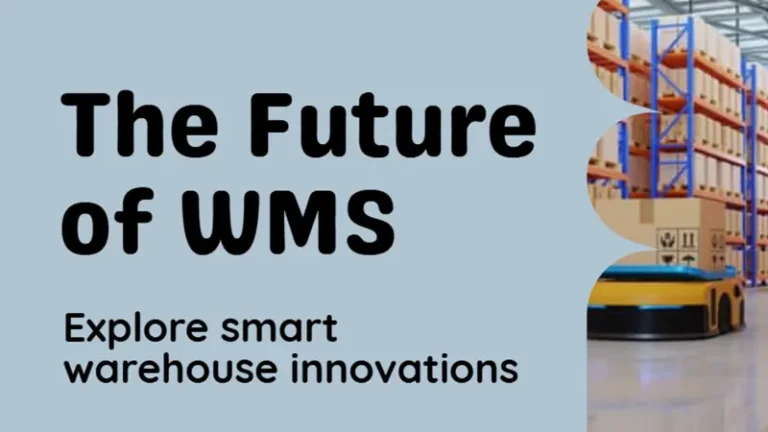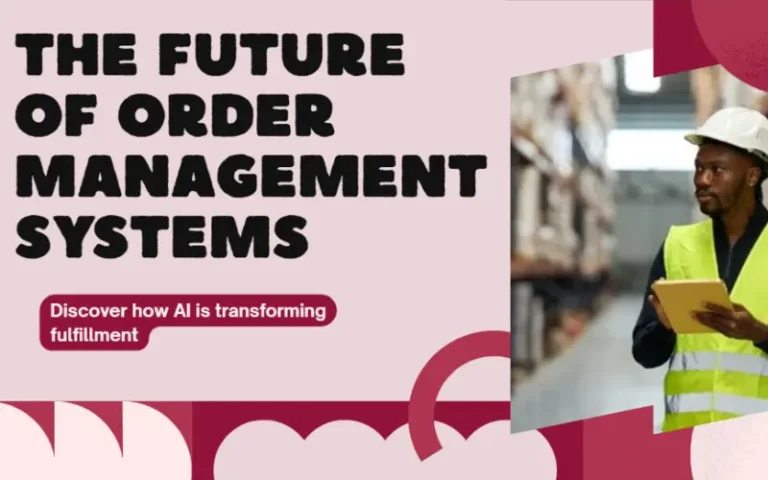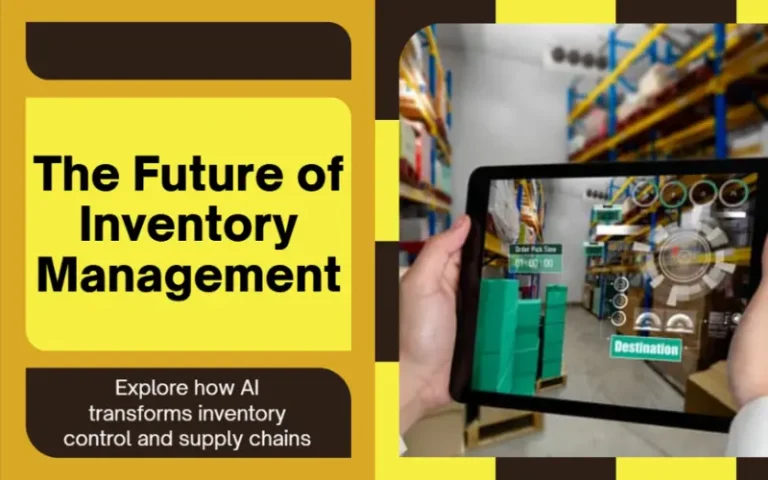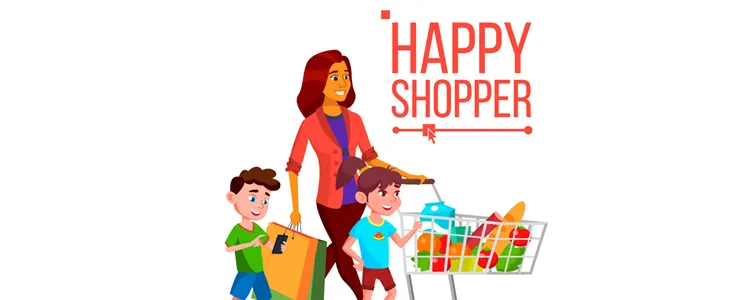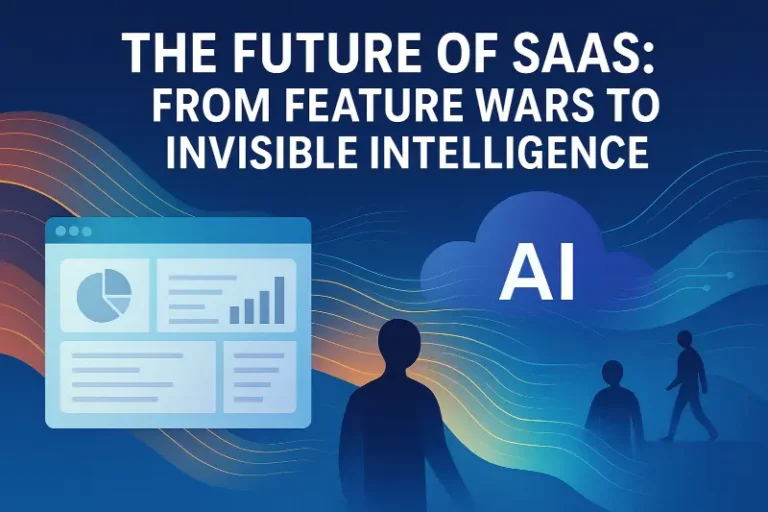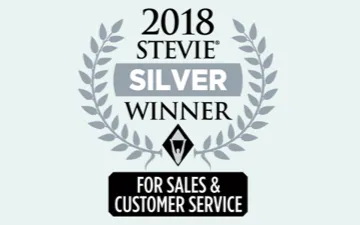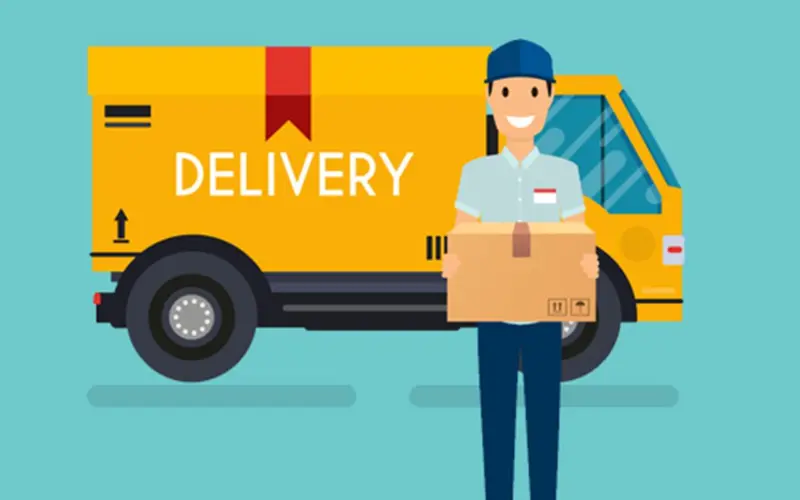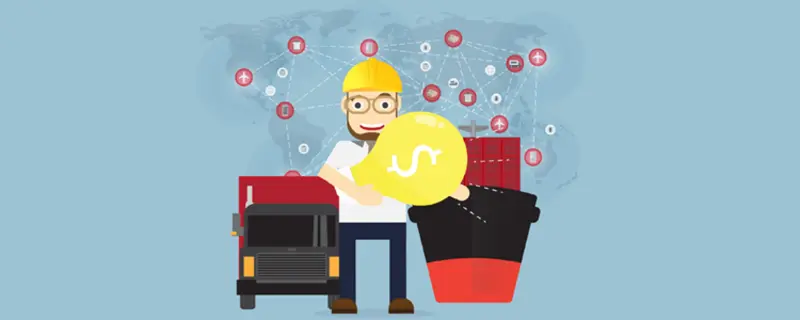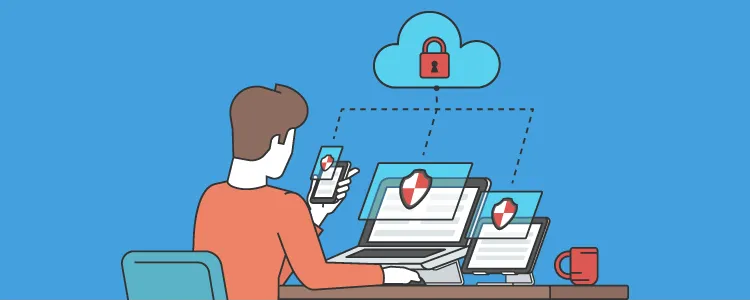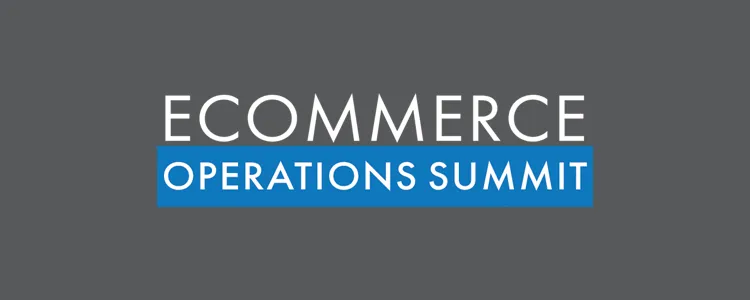Understanding Backorder Meaning: Causes, Challenges, and Solutions
Backorders can be both a challenge and an opportunity for growing businesses. A backorder happens when an item is temporarily out of stock but still available for purchase, with fulfillment expected once inventory is replenished. If managed properly, backorders allow you to continue generating revenue during high-demand periods or supply delays. However, poor backorder handling can lead to customer frustration, negative reviews, or canceled orders. This article explains what causes backorders, how to communicate clearly with customers, and how to implement a strategy that protects both your revenue and reputation.
Key Takeaways
- Backorders are for items that are not in stock but can be ordered with a guaranteed future delivery date, while out-of-stock items cannot be purchased at all.
- Common causes of backorders include supply chain disruptions, unexpected surges in demand, and inadequate safety stock.
- To minimize backorders, businesses should focus on accurate demand forecasting, maintain safety stock, set reorder points, and diversify suppliers.
Defining Backorders
The term backorder refers to orders for items that are not currently in stock but are promised to be fulfilled when they become available. Essentially, a backorder indicates that the demand for a product exceeds what the Seller has produced or currently holds in inventory. This often happens when demand surpasses supply, leading to a situation where customers can still place orders for items that will be shipped at a future date.
When a customer places an order for a backordered item, they are generally provided with a future ship date or ship date range, which is when the item is expected to be back in stock. This means that although the product is not available for immediate shipment, it is guaranteed to be delivered within a specified timeframe. For instance, if a customer orders a pair of shoes that are not in stock but are expected to arrive in two weeks, the order is placed on backorder.
Orders containing backorder items cannot be packed and shipped immediately. They may be split if other items in the order are in stock, leading to partially backordered items. When orders are split, the missing items should be clearly marked on the packing slip as being backordered.
Common causes of backorders include unexpected surges in demand, such as those triggered by viral trends or seasonal spikes. Understanding these dynamics helps businesses manage their inventory more effectively and maintain customer satisfaction.
Backorders vs Out of Stock
Differentiating between backordered and out-of-stock items is important for both businesses and customers. As discussed, backordered items are those that customers can still purchase, with the promise of future delivery. In contrast, out-of-stock items are unavailable for purchase until they are restocked. This distinction means that while backordered items provide a clear restock date, out-of-stock items do not offer such guarantees, and replenishment may never happen.
Backorders allow businesses to maintain a connection with their customers even when stock is depleted, but known future quantities are available. Customers who order backordered items are assured that their purchases will be fulfilled, fostering trust and continued engagement. Conversely, labeling items as out of stock can deter potential sales and weaken customer loyalty.
Deciding whether to classify a product as backordered or out of stock depends on factors such as customer patience and sourcing capabilities. Understanding this difference helps businesses optimize their inventory management and meet customer demand more effectively.
Slash Your Fulfillment Costs by Up to 30%
Cut shipping expenses by 30% and boost profit with Cahoot's AI-optimized fulfillment services and modern tech —no overheads and no humans required!
I'm Interested in Saving Time and MoneyCommon Causes of Backorders
Backordered inventory typically arises from various factors, including:
- Supply chain disruptions, such as adverse weather conditions or manufacturing delays
- Unusual spikes in customer demand
- Inadequate safety stock
- Supplier or raw material issues
The following subsections will delve deeper into why backorders occur, providing insights into how unexpected demand, low safety stock levels, and supplier problems can lead to backorders.
Unusual Demand
Unusual demand can lead to backorders, particularly when it is sudden and unexpected. Common causes of such surges include seasonality, media exposure, celebrity/influencer endorsements, and new marketing channels. For instance, a successful marketing campaign can trigger significant spikes in product demand, outpacing the available supply when demand exceeds supply.
Sales or promotions can also create sudden increases in customer demand, for example, landing a spot on Good Morning America’s Deals and Steals segment. However, if these spikes are not accurately forecasted, they can result in backorders as the supply may not meet the sudden increase in customer requests.
Low Safety Stock
Mismanagement of inventory levels can result in inadequate safety stock, contributing to backorders. Even with normal demand, miscalculating safety stock levels can lead to backorders. Insufficient stock levels due to improper preparation or counting can cause backorders.
Maintaining appropriate safety stock levels is essential to prevent backorders and meet customer demand. Effective inventory management involves keeping a buffer of safety stock to cover unexpected demand and supplier issues.
Supplier Issues
Manufacturer or supplier problems can result in backorders. These supply chain issues can manifest as delays in shipping or shortages of raw materials needed for production. Utilizing multiple suppliers can help maintain consistent inventory levels and mitigate supply chain risks.
A diversified supplier base is crucial for minimizing the impact of supplier-related backorders. Having multiple suppliers ensures a steady supply chain and reduces vulnerability from relying on a single source.
Advantages of Selling on Backorder
Selling on backorder enhances the perceived demand for products, making them more appealing to customers. When customers see that an item is on backorder, it can create a sense of urgency and exclusivity, driving higher interest and sales.
Improved cash flow is another key benefit of selling products on backorder, as businesses can receive payment before delivering the products. This pre-payment can be good for managing financial resources and planning future inventory purchases. Additionally, selling on backorder, the space required to store the inventory, increasing available storage space, and reducing warehousing costs.
Offering items on backorder can also lead to higher product demand. Customers who are willing to wait for their desired products can help maintain continuous sales momentum, even when certain items are not immediately available. And the extended delivery expectation set with buyers provides for using less expensive shipping services because there is no immediacy built into the purchase, which drives up shipping costs (and drives down margins).
Disadvantages of Selling on Backorder
Despite its advantages, selling on backorder comes with several drawbacks. One significant disadvantage is the potential for loss of sales, as customers may seek alternatives if they are unwilling to wait for backordered items. This loss of sales can directly impact a business’s revenue.
Longer wait times for customers can lead to dissatisfaction and increase the likelihood of order cancellations. This dissatisfaction can result in a loss of customers, as they may choose to shop elsewhere in the future.
Additionally, managing backorders can increase the use of resources, as businesses need to handle customer inquiries, process refunds, and manage additional logistics.
Overall, while selling on backorder can be beneficial, businesses must be prepared to manage the challenges and potential downsides effectively.
Looking for a New 3PL? Start with this Free RFP Template
Cut weeks off your selection process. Avoid pitfalls. Get the only 3PL RFP checklist built for ecommerce brands, absolutely free.
Get My Free 3PL RFPStrategies to Minimize Backorders
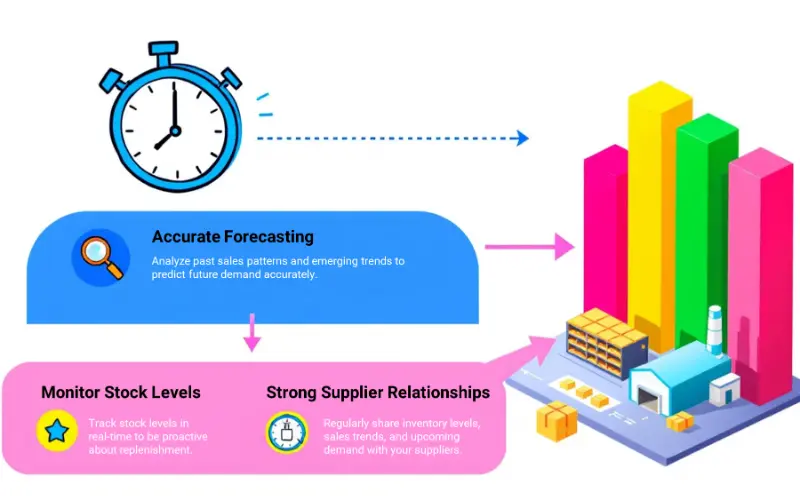 To minimize backorders, businesses must implement effective inventory management strategies. Accurate demand forecasting based on past sales data is essential for managing inventory and reducing backorders. Also, endeavor to maintain safety stock to ensure inventory levels can meet unexpected demand and mitigate the risk of backorders.
To minimize backorders, businesses must implement effective inventory management strategies. Accurate demand forecasting based on past sales data is essential for managing inventory and reducing backorders. Also, endeavor to maintain safety stock to ensure inventory levels can meet unexpected demand and mitigate the risk of backorders.
Setting reorder points based on historical sales data helps prevent stockouts and minimizes the likelihood of backorders. Working with multiple suppliers ensures a steady supply chain and can mitigate the risks associated with having only one supplier. Lastly, regularly check inventory levels through regular cycle counts as SKUs near depletion to minimize backorders and respond promptly to any warehouse management discrepancies.
Maintain Safety Stock
Safety stock in inventory management covers unusual demand and supplier issues. Having the right amount of safety stock optimizes inventory use and capital, preventing stockouts. A solid business strategy that keeps popular items in stock is key to minimizing backorders.
Businesses should prioritize inventory items by importance to customers to manage backorders effectively. Focusing on popular and high-demand items ensures sufficient stock to meet customer demand and avoid backorders.
Set Reorder Points
Reorder points should factor in lead times to ensure timely replenishment. Safety stock levels must also be incorporated into reorder point calculations to buffer against unexpected demand. Setting precise reorder points is essential to prevent stockouts and maintain inventory efficiency.
Combining historical data with accurate lead times and safety stock levels allows for effective reorder point settings. This approach ensures that businesses can maintain optimal inventory levels and minimize the risk of backorders.
Diversify Suppliers
Supplier diversification mitigates risks by ensuring availability during disruptions. Over-reliance on a single supplier can increase vulnerability if problems arise. Working with multiple suppliers provides options to fulfill orders, reducing the risk of backorders.
Building relationships with various suppliers can lead to better pricing and terms, further enhancing inventory management. However, vendor diversification adds complexity in management and coordination efforts, which businesses must be prepared to handle.
Customer Management During Backorders
Effective customer management during backorders is crucial for maintaining satisfaction and loyalty. Keep customers informed about delays and updates to gain their trust and engagement. Offering discounts or coupons on future orders can serve as an incentive for customers waiting for backordered items.
Shipping partial orders and waiving extra shipping charges can improve the customer experience. Automated emails can generate anticipation and maintain interest while keeping customers informed and connected to the business.
Clear Communication
Transparent communication about expected delays can significantly enhance customer trust. Provide order status updates and clarity on backorder timelines. Keeping customers informed helps manage expectations and reduce frustration and order cancellations. Regular communication ensures that customers feel valued and understood, even during delays.
Build Excitement
Regular updates on the status of backordered items can help sustain customer interest and enhance the overall shopping experience. This engagement can turn a potential negative (the wait) into a positive anticipation. Creating excitement around backordered items can also build brand loyalty and encourage customers to wait for their desired products rather than go shopping somewhere else.
Offer Alternatives
Offering alternative products allows customers to find suitable replacements that potentially fulfill a pressing need, eliminating the frustration of having to wait for the order to arrive.
Offering incentives, such as discounts or loyalty points, can encourage customers to accept backordered items or alternatives as a quid pro quo. These strategies improve customer satisfaction and loyalty, ultimately leading to positive brand perception and increased lifetime customer value.
Scaling Made Easy: Calis Books’ Fulfillment Journey
Learn how Calis Books expanded nationwide, reduced errors, grew sales while cutting headcount, and saved BIG with Cahoot
See Scale JourneySummary
Understanding backorders is essential for both businesses and customers. Backorders indicate that demand exceeds supply, but they allow continued sales and customer engagement even when stock is depleted. Differentiating between backorders and out-of-stock situations is necessary for effective inventory management and transparency.
By identifying and addressing the common causes of backorders, such as unusually high demand, low safety stock, and supplier issues, businesses can minimize their impact. Effective customer management during backorder situations, through clear communication, building excitement, and offering alternatives, can provide for an enjoyable customer experience and lead to a healthy, long-term relationship.
Frequently Asked Questions
What is a backorder?
A backorder is simply when you order something that’s out of stock but it will be shipped to you once it’s back in inventory. This means you might have to wait a bit, but your order is still secure!
How do backorders differ from out-of-stock items?
Backordered items can still be bought with a promise to deliver later, while out-of-stock items aren’t available for purchase at all until they are restocked. So, if you’re placing a backorder, you know it’s on its way eventually!
What are some common causes of backorders?
Backorders often happen due to unexpected spikes in demand, insufficient safety stock, and problems with suppliers. Keeping a close eye on these factors can help prevent this frustrating situation.
How can businesses minimize backorders?
To minimize backorders, focus on maintaining safety stock, accurately setting reorder points, and diversifying your suppliers. These strategies will help ensure that you have enough inventory on hand to meet demand.
What strategies can help manage customer expectations during backorders?
Managing customer expectations during backorders is all about clear communication and keeping them in the loop with regular updates. You can also offer alternative products or incentives to keep their interest piqued.

Turn Returns Into New Revenue
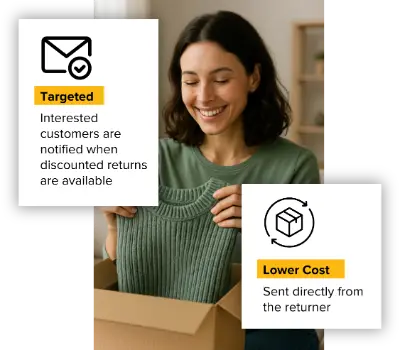
Ecommerce Returns Fraud: Rising Threats and Loss Prevention Strategies
Returns fraud and abuse have escalated into a significant threat, posing substantial challenges for retailers attempting to maintain customer-friendly free return policies. This form of fraud ranges from minor deceptions to complex schemes, making it essential for businesses to identify and mitigate abusive practices without alienating legitimate customers. Understanding the types of returns fraud, who commits it, and implementing prevention strategies can help retailers minimize their losses while maintaining consumer trust and loyalty.
Types of Returns Fraud and Abuse
Returns fraud takes several forms, each impacting e-commerce businesses differently. One of the most common practices is lying about delivery, where individuals claim they never received an item, even though it was delivered. Fraudsters can retain the product and the refund by exploiting policies on lost shipments.Another frequent issue is fraudulent claims of damage, defects, or missing parts. Customers may falsely report a defect to secure a refund while keeping or reselling the product. Similarly, some buyers use “wardrobing”— purchasing clothing or accessories to wear them briefly before returning them. This is incredibly challenging for retailers in the fashion industry.
Returning empty boxes or different items entirely is also on the rise. Perpetrators may return a box with unrelated or worthless items, claiming it contains the original purchase. High-value electronics, luxury goods, and designer apparel are frequent targets, where returns often involve counterfeit items or used products. Furthermore, some customers keep items delivered by mistake, exploiting policies that may not require a return for the retailer’s error.
In addition to these behaviors, more severe fraud occurs with stolen merchandise returns and transactions using stolen or fraudulent payment methods. Some individuals attempt to return goods purchased through fraudulent credit cards, adding to retailers’ challenges. Employee fraud or collusion also contributes to the issue, with insiders manipulating the system to process unauthorized returns for personal gain or on behalf of others. The complexities of returns fraud require multi-layered strategies to detect, prevent, and manage such abuses effectively.
Slash Your Fulfillment Costs by Up to 30%
Cut shipping expenses by 30% and boost profit with Cahoot's AI-optimized fulfillment services and modern tech —no overheads and no humans required!
I'm Interested in Saving Time and MoneyTypical Profiles of Returns Fraud
Returns fraud occurs across demographics but shows some patterns. Studies indicate specific trends by gender, age, and income level, with fraud appearing in both high-income and lower-income brackets. Younger consumers, often with lower income and less established shopping histories, are more likely to engage in returns abuse, especially practices like wardrobing or bracketing (which is when multiple sizes or variants of the same item are ordered to return most purchases, which technically remains legal, but it creates significant operational strain on retailers). High-income individuals, however, may commit fraud on a larger scale, potentially exploiting high-value items and finding loopholes in luxury goods policies. Understanding these demographic patterns helps retailers tailor their prevention strategies to target the most prevalent forms of abuse within their customer base.Strategies to Curb Returns Fraud
Combating returns fraud requires a comprehensive approach that balances fraud prevention with the need for positive customer experiences. Clear return policies outlining the eligibility criteria for refunds in plain language and using exchanges and store credits are essential. Detailed policies help set expectations, minimize ambiguity, and limit avenues for abuse. Including specific stipulations, such as original packaging requirements, limited return windows, and proof of purchase for returns (such as providing the original Order Number), can deter fraudulent attempts without overly restricting genuine customers.Advanced fraud detection tools have become indispensable. Machine learning algorithms analyze purchasing and return patterns, identifying red flags like repeat returns without receipts, returns from different locations than the original shipping address, or multiple returns in short timeframes. These tools allow retailers to monitor abnormal behavior and intervene before fraud becomes costly. Additionally, some companies are adopting SKU-level data analysis to track trends for specific products and adjust return policies accordingly.
Retailers can also implement strategies that add a layer of verification for certain returns. For example, requiring photographs of damaged items or using unique serial numbers to verify high-value items can prevent fraudulent claims. Similarly, forcing returns to a physical store instead of online can reduce the likelihood of fraud, as in-store returns involve an extra layer of human oversight.
Other deterrents include offering store credits or gift cards instead of direct refunds, which keeps revenue within the business while reducing the monetary incentive for return abuse. For certain items, restocking fees can offset return processing costs and discourage unnecessary returns. Some retailers are also experimenting with date-certain delivery options to reduce claims about late or missing items, which often contribute to fraudulent refunds.
Leveraging AI and Automation in Fraud Prevention
Artificial intelligence (AI) offers cutting-edge solutions for identifying returns fraud. AI algorithms can sift through extensive datasets to flag suspicious patterns across metrics like purchase history, location, and return frequency. These insights enable retailers to preemptively identify potential fraudsters and apply stricter policies to accounts that exhibit high-risk behavior.Moreover, automated systems streamline the returns management process, minimizing human error and consistently enforcing policies. They can verify the integrity of a return by tracking product serial numbers or assigning unique IDs to high-value items. Integration with third-party data sources allows retailers to cross-reference transaction history, adding another layer of protection against fraudulent returns. Using AI and automation reduces operational strain while enabling retailers to implement scalable, data-driven fraud prevention measures.
Looking for a New 3PL? Start with this Free RFP Template
Cut weeks off your selection process. Avoid pitfalls. Get the only 3PL RFP checklist built for ecommerce brands, absolutely free.
Get My Free 3PL RFPThe Balance Between Fraud Prevention and Customer Loyalty
While implementing robust fraud prevention measures, businesses must remain cautious not to damage customer loyalty. Frequent return customers are loyal shoppers with higher lifetime value, so overly restrictive policies could alienate these valuable clients. Providing transparency in return policies and communicating the rationale behind certain restrictions helps maintain a positive relationship with legitimate customers.Personalizing return policies based on customer purchase and return history can foster trust. For example, loyal customers may receive extended return windows or expedited refund processing, while high-risk accounts may face tighter restrictions or be limited to store credit. This personalized approach allows retailers to tailor their policies without compromising fraud prevention goals.
Summary
Returns fraud is a complex challenge for the e-commerce sector, demanding a nuanced approach that combines policy enforcement, advanced technology, and demographic insights. As fraud techniques evolve, retailers must stay vigilant and proactive, implementing adaptive systems that address the risks associated with modern returns fraud.A successful fraud prevention strategy requires the right balance between security and customer satisfaction, ensuring that restrictive policies do not burden legitimate shoppers. By prioritizing transparency, adopting advanced technology, and continuously refining returns processes, retailers can mitigate losses from fraudulent returns while fostering a trusted shopping environment that encourages consumer loyalty. In the fast-paced world of e-commerce, strategic fraud prevention is not just a protective measure—it is essential for long-term success and profitability.
Learn more about using returns as a competitive advantage and increasing revenue and profitability accordingly.

Turn Returns Into New Revenue

Turning Today’s Smart Shoppers into Loyal Customers
When you ring up a sale with a brand new customer, whether online or in a store, is that the end of the relationship? Or is it just the beginning? In her best-selling book “The Membership Economy,” Robbie Kellman Baxter makes a clear case for the latter. The economics are profound, as it costs 7x more to acquire a new customer than to earn a repeat visit.
Brand loyalty is the key to growth for almost all retail categories. Whether your business relies heavily on repeat visits (e.g. sports apparel stores) or on low frequency purchases (e.g. a wedding reception decorations retailer), brand loyalty matters. You’d love for that soccer aficionado to shop every season. And you’d love for a recent bride to recommend your store, whether online or brick & mortar, to her friends when the time comes.
You build loyalty through great shopping experiences and customer touch points. One hundred years ago, those experiences began in stores, through interactions with store associates. And they continued with ongoing personal relationships. People’s lives centered on relatively small geographic areas, and retailers learned about their customers in person. Today, we are a mobile society. Store associates aren’t lifetime employees, and loyal shoppers visit multiple locations of their favorite retailers, including online.
The proliferation of customer touch points during the past 20 years has been immense. Meanwhile, your ability to truly know your customers, and how they interact with you, has become near impossible. Consider a shopper who just walked into one of your stores. Imagine if store associates knew the answers to all of these questions:
- Did she do any research before walking in? What products was she browsing?
- Has he shopped here previously? What did he buy and what brands does he like most?
- How happy was she with her last purchase here? Has she returned anything?
- Has he purchased from us online? Was it from our site? Or from a marketplace?
- Does she talk about our category, or about us, on social media?
- Have we interacted with him after the sale? Live chat? Contact Center? Chat bots?
Slash Your Fulfillment Costs by Up to 30%
Cut shipping expenses by 30% and boost profit with Cahoot's AI-optimized fulfillment services and modern tech —no overheads and no humans required!
I'm Interested in Saving Time and MoneyYour customer is capable of remembering all of it. And increasingly, as shoppers, they expect you to remember too — to know them across all the touch points they’ve experienced with you. And while technology is the driver behind channel proliferation, technology has not kept up with your need to know about all of those new types of interactions as your customers move from your site, to your store, to the telephone contact center. And back to the store again.
In this whitepaper, we will explore the challenges that retailers face in delivering omnichannel customer satisfaction as well as the solutions.
We will follow customers along the buyer journey.
How can you treat individual customers consistently, as if your brand truly knows them, regardless of whether they are on social media, buying on a marketplace, or in your store? And given that we can’t possibly know every single touch point, how can we, at a minimum, intelligently ensure that every interaction that customers have will be positive.
We will also, for many of the touchpoints within each step, cover the foundational capabilities you need in place, as well as those that will help you achieve omnichannel excellence.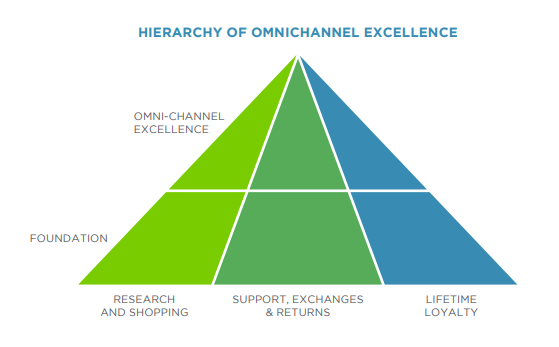
Customer Loyalty Building Blocks
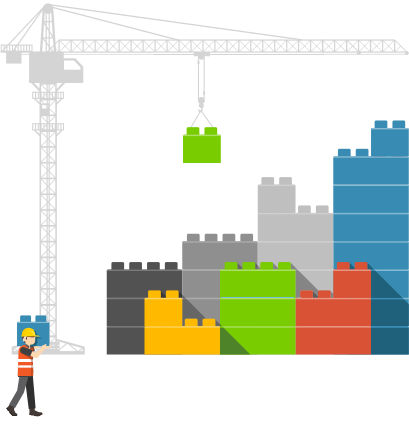
Intuitively, if you’re a retailer, you know that loyalty begins with the basics. Customers have needs, and they come to you to buy the products that will satisfy those needs.
- “I’m having a wedding, and I need party favors.”
- “Soccer season begins in 3 weeks, and I need practice gear.”
- “We’re headed to Mexico for the winter holiday, and I need SPF 30 swimwear.”
Looking for a New 3PL? Start with this Free RFP Template
Cut weeks off your selection process. Avoid pitfalls. Get the only 3PL RFP checklist built for ecommerce brands, absolutely free.
Get My Free 3PL RFPThe Basics
As a retailer, you help shoppers find the products that will make them happy, and you make the purchase process as easy as possible. You deliver where and when you promised you would. And, if your new customer has questions, or wants to return or exchange a product, you answer their questions quickly and make returns and exchanges simple too. You might even go a step further, with a basic loyalty program that rewards purchases.
Except, the basics aren’t simple anymore, because at every step of the buyer journey, customers are not just changing lanes on the highway, they’re switching from planes, to trains to automobiles… to SpaceX (see figure 1).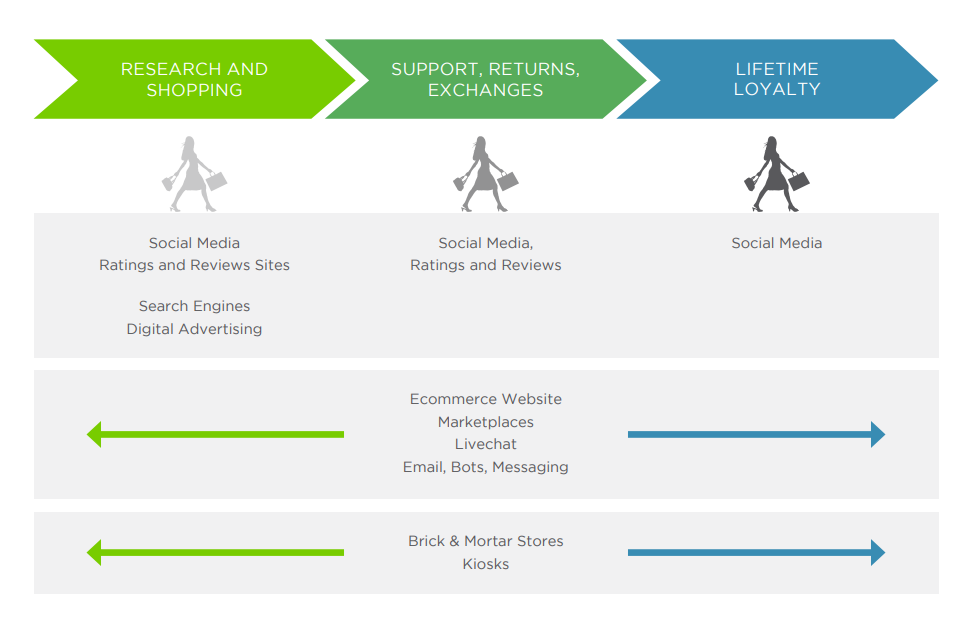
Shopping and Research
To serve your well-informed customers better, you need to know what they know. Before entering the store, what did they learn from google searches, reviews, twitter and your Facebook page? How does pricing and return policy vary between your ecommerce site, marketplaces, and your stores? Are your contact centers giving the same answers to the same questions as your live chat operators and your store associates?
Support, Returns & Exchanges
Return and exchange policy and execution are two of the most important factors consumers consider when choosing a retailer – whether buying online or in stores. In fact, according to the UPS Pulse of the Online Shopper™ study, 66% of shoppers review a retailer’s return policy before making a purchase. At a minimum, this must be a simple process. More advanced retailers are enabling customers to buy, modify an order, return and exchange across multiple contact channels. The easier we make it for customers, the more likely they are to return.
- Are each of your channels providing great support?
- Are they able to interact with a customer the same across all channels?
- Or is your company treating one customer like three:(1) the store customer, (2) the website customer, and(3) the call center customer?
Lifetime Loyalty
Loyalty programs are everywhere we turn. From buy 10, get 1 free punch cards, to rewards points, to discounts off the next purchase, retailers are in an arms race to keep customers coming back. And loyalty programs help you get to know your customers better too. Are you keeping your customers engaged with your brand after they walk out with their first purchase?
Scaling Made Easy: Calis Books’ Fulfillment Journey
Learn how Calis Books expanded nationwide, reduced errors, grew sales while cutting headcount, and saved BIG with Cahoot
See Scale JourneyThe Basics Matter
While there are a myriad of initiatives within each loyalty driver that we can enhance, retailers ignore the basics at their peril:
- 89% of customers have stopped buying from online stores after they’ve experienced poor service (source: Right Now)
- A 5% reduction in customer abandonment rate can increase profitability by 25% – 125%. (Source: “Leading on the Edge ofChaos,” Murphy & Murphy)

Turn Returns Into New Revenue

Retailers Need a 360-degree Customer View to Win: Turning Today’s Smart Shoppers into Loyal Customers
Why Retailers Need a 360-degree Customer View to Win in the Omnichannel Age
Introduction
When you ring up a sale with a brand new customer, whether online or in a store, is that the end of the relationship? Or is it just the beginning? In her best-selling book “The Membership Economy,” Robbie Kellman Baxter makes a clear case for the latter. The economics are profound, as it costs 7x more to acquire a new customer than to earn a repeat visit.
Brand loyalty is the key to growth for almost all retail categories.
Whether your business relies heavily on repeat visits (e.g. sports apparel stores) or on low frequency purchases (e.g. a wedding reception decorations retailer), brand loyalty matters. You’d love for that soccer aficionado to shop every season. And you’d love for a recent bride to recommend your store, whether online or brick & mortar, to her friends when the time comes.
You build loyalty through great shopping experiences and customer touch points.
One hundred years ago, those experiences began in stores, through interactions with store associates. And they continued with ongoing personal relationships. People’s lives centered on relatively small geographic areas, and retailers learned about their customers in person. Today, we are a mobile society. Store associates aren’t lifetime employees, and loyal shoppers visit multiple locations of their favorite retailers, including online.
The proliferation of customer touch points during the past 20 years has been immense.
Meanwhile, your ability to truly know your customers, and how they interact with you, has become near impossible. Consider a shopper who just walked into one of your stores. Imagine if store associates knew the answers to all of these questions:
- Did she do any research before walking in? What products was she browsing?
- Has he shopped here previously? What did he buy and what brands does he like most?
- How happy was she with her last purchase here? Has she returned anything?
- Has he purchased from us online? Was it from our site? Or from a marketplace?
- Does she talk about our category, or about us, on social media?
- Have we interacted with him after the sale? Live chat? Contact Center? Chat bots?
Your customer is capable of remembering all of it. And increasingly, as shoppers, they expect you to remember too — to know them across all the touch points they’ve experienced with you. And while technology is the driver behind channel proliferation, technology has not kept up with your need to know about all of those new types of interactions as your customers move from your site, to your store, to the telephone contact center. And back to the store again.
Looking for a New 3PL? Start with this Free RFP Template
Cut weeks off your selection process. Avoid pitfalls. Get the only 3PL RFP checklist built for ecommerce brands, absolutely free.
Get My Free 3PL RFPIn this whitepaper, we will explore the challenges that retailers face in delivering omnichannel customer satisfaction as well as the solutions.

Turn Returns Into New Revenue

Pulse Commerce Wins Customer Service of the Year Stevie Award
March 5, 2018 – Bridgeport, CT – Pulse Commerce, the leading cloud platform for Order & Inventory Management, announced today that it won a prestigious Stevie Award for Customer Service Department of the Year. The company was awarded Stevie’s 2018 Silver Award in recognition of the innovations added to its client services department over the last year, and for its continuous commitment to provide best in industry customer service.
Pulse Commerce earned a Silver this year through a number of customer service innovations:
- Support process overhaul – Rebuilt the entire support process from scratch, with automatic ticket prioritization based on issue severity and SLA due date (service level agreement). With automated ticket prioritization, agents avoid constant review and re-review of open tickets to determine which one to resolve next. Efficiency and productivity have improved dramatically, virtually eliminating ‘stale tickets’ that accidentally stay open too long.
- All new Help Center – launched a completely redesigned multi-media Help Center with a modern and streamlined experience, faster navigation and easier discoverability. Pulse Commerce more than doubled the size of its online knowledgebase, which now includes over 250 fresh articles and videos. Pulse Commerce also introduced a mechanism for accepting new Help article and video tutorial requests from clients, ensuring that the most relevant content is being added to the new Help Center.
- Faster and more convenient ticket management – added a brand-new Ticket Manager directly within the Pulse Commerce Admin Panel. Merchants now manage all Support Requests from a single online dashboard, where they can search their organization’s tickets, view status, and update ticket content.
- After-hours service improvements – Pulse Commerce’s customer service department integrated Slack for teams, enabling faster and more reliable after-hours priority incident resolution. In concert with the 8×8 Voice Over IP system, the team is empowered to take calls from anywhere, using any device. The combination of these technologies working seamlessly together enables full-time emergency customer support, living up to the company’s promise of providing exceptional customer support at all times.
More than 2,500 nominations from organizations of all sizes and in virtually every industry were evaluated in this year’s competition. Winners were determined by the average scores of more than 150 professionals worldwide in seven specialized judging committees.
I’m very proud of our client services team, led by Jeremy Stewart. Thanks to the team’s relentless customer focus and innovative solutions, our clients have enjoyed marked improvements in their experience. Average daily new ticket creation was reduced by 40% and our customer satisfaction rating is now at 98%.
~Manish Chowdhary
CEO, Pulse Commerce
All of our Stevie Award winners should be proud of their achievements. Independent professionals around the world have agreed that their accomplishments are worthy of our public recognition.
~Michael Gallagher
President, Stevie Awards
Slash Your Fulfillment Costs by Up to 30%
Cut shipping expenses by 30% and boost profit with Cahoot's AI-optimized fulfillment services and modern tech —no overheads and no humans required!
I'm Interested in Saving Time and Money
About Pulse Commerce
Pulse Commerce is the leading cloud platform for enterprise order & inventory management, empowering retail leaders with unprecedented visibility and control of inventory, orders and customers. Retailers rely on Pulse Commerce to improve order turnaround, increase customer satisfaction, and optimize inventory control and fulfillment costs.
About the Stevie Awards
Stevie Awards are conferred in seven programs: the Asia-Pacific Stevie Awards, the German Stevie Awards, The American Business Awards, The International Business Awards®, the Stevie Awards for Great Employers, the Stevie Awards for Women in Business and the Stevie Awards for Sales & Customer Service. Stevie Awards competitions receive more than 10,000 entries each year from organizations in more than 60 nations. Honoring organizations of all types and sizes and the people behind them, the Stevies recognize outstanding performances in the workplace worldwide. Learn more about the Stevie Awards at www.StevieAwards.com.

Turn Returns Into New Revenue

5 Ways to Improve the Parcel Delivery Experience
“The last mile” is now the Holy Grail of ecommerce shipping. A merchant can do an amazing job of selling and provide an outstanding shopping experience, yet if the package is late or damaged, a customer may complain on social media, even if the carrier is to blame.
You can’t directly control the last mile — i.e., the distance from a local transportation hub to the final destination — but you can improve the communication with your customer to provide excellent service, even when things go wrong.
Here are a few ways that merchants can provide an outstanding delivery experience and produce a positive brand impression.
5 Ways to Improve the Parcel Delivery Experience
1. Avoid porch pirates. Porch pirates are thieves that steal parcels from recipients’ porches. Many articles have been written about how to prevent this type of theft. Ideas include security cameras, lockers, and services like Package Guard, which notifies a recipient when a package is delivered.
But the most foolproof way to avoid theft is to ensure that the customer is home when the parcel arrives. Retailers can schedule delivery times and provide frequent delivery notifications (see 3., below), so consumers know when to be home. Saturday delivery options provide even more opportunities to stop package theft.
2. Provide delivery windows, with options. Customers expect tight delivery windows — ideally, 8 a.m. to 12 p.m. on a specific day, with notification an hour or so before delivery. Provide the ability for your customers to choose a delivery date and, if possible, a time.
Even better, empower them with different ways to receive packages. For example, Jet.com is installing Latch, a sophisticated access system, in 1,000 New York City apartment buildings for easier deliveries. Residents can use their phone as a key, grant access to guests without walking downstairs, and get packages delivered safely without being home.
Also, Amazon Locker is available to merchants using Fulfillment by Amazon. It is similar to a post office box, but only for Amazon deliveries. Customers get an email as soon as the package arrives at the locker and they have three days to pick it up. Similar services include FedEx Ship&Get, USPS Gopost, and UPS Access Point lockers.
Amazon is also testing delivering directly to customers’ car trunks, while Walmart is testing deliveries straight to customers’ refrigerators. Commitment to improving the last mile experience is immense. Independent merchants should not be too far behind.
Slash Your Fulfillment Costs by Up to 30%
Cut shipping expenses by 30% and boost profit with Cahoot's AI-optimized fulfillment services and modern tech —no overheads and no humans required!
I'm Interested in Saving Time and Money3. Send frequent delivery notifications via preferred mediums. Customers have their own preferred forms of communication. The more choices they have, the more likely they are to receive and read your updates. The top three consumer choices for communication are typically email, text message, and a company order-tracking page. As a start, offer all three.
Customers appreciate being notified when an order is going to ship, when it has shipped, where the item is currently located, and ongoing updates about the expected delivery date and time.
There are plenty of exceptions to these typical notices. You’ll earn loyalty points with your customers if you handle them well, and proactively. Examples include:
- Attempted delivery by the carrier, without success.
- Available for pickup at a carrier location, after too many attempted deliveries.
- Cannot schedule a delivery appointment, and the carrier is unable to reach the customer.
- Consignee refused delivery, usually because it was delivered to the wrong address.
- Other exceptions, including expected delays, package held at terminal, and incorrect address.
4. Provide a branded tracking page. A branded delivery-tracking page is a must have. Customers become increasingly engaged with your brand during the period between the purchase and delivery. According to the 2017 “Post-Purchase Benchmark Report” from Navar, a customer loyalty and retention platform:
- Those who track orders visit the tracking page 3.1 times per order.
- The click rate on marketing assets that appear on a branded order-tracking page is 3-times higher than for marketing emails
A branded tracking page will curtail “Where is my order?” customer-service queries. It will also provide your marketing team with better opportunities to cross sell, up sell, and boost engagement.
5. Offer branded and eco-friendly packaging. Branded packaging is a effective way to advertise. It’s similar to a mobile billboard. Remember the first time you saw a package from Jet.com? Or the ubiquitous Echo and Prime advertisements on every Amazon box? The more eye-catching your packaging is, the more your customers and their neighbors will remember it.
Eco-friendly packaging is becoming more important, especially for millennials. One recent study found that more than 50 percent of shoppers would pay more for environmentally friendly packaging.
Looking for a New 3PL? Start with this Free RFP Template
Cut weeks off your selection process. Avoid pitfalls. Get the only 3PL RFP checklist built for ecommerce brands, absolutely free.
Get My Free 3PL RFPExecution Is Key
Parcel delivery strategies are easy to articulate, but hard to execute well. Managing delivery in the last mile requires infrastructure for order and fulfillment that can track real-time package status from origin to the customer’s doorstep and everywhere in between. That information must sync with numerous platforms — website, customer support, email, text messages — and accommodate order and delivery modifications. Get it all right and you’ll have an unfair competitive advantage.

Turn Returns Into New Revenue

7 Ways Retailers Can Make Free Shipping Profitable
One of the most important and potentially expensive decisions that an online retailer can make is whether or not to offer free shipping. Over 2 million Google searches each month in the United States include the phrase “free shipping.” Most online merchants have at least considered offering it. It’s a tough decision because shipping is expensive — Amazon’s shipping expense was $16.2 billion in 2016, over 17 percent of its total order value.
How can a retailer afford an additional 15 to 20 percent expense?
The good news is that you can.
Begin with a simple A/B test, in which a random sample of shoppers — 10 to 50 percent — is offered free shipping. Compare the control group with the test group to see the change.
Then, track three outcomes to determine the real cost of offering free shipping.
- Change in conversion rate. For example, a change from 5 percent to 6 percent is a 20 percent increase, or 1.2 expressed as a decimal. In the equation below, it’s variable A.
- Change in average order value. An AOV improvement from $50 to $51 is a 2 percent increase, or 1.02 expressed as a decimal — variable B, below.
- Change in gross margins. If the control group gross margin is 50 percent, and the test group gross margin is 35 percent, then the gross margin decrease is 30 percent: -15% ÷ 50% = -30%.This is -0.3 expressed as a decimal. It’s variable C, below.
Slash Your Fulfillment Costs by Up to 30%
Cut shipping expenses by 30% and boost profit with Cahoot's AI-optimized fulfillment services and modern tech —no overheads and no humans required!
I'm Interested in Saving Time and MoneyNext, compute the percentage change in profit from offering free shipping, as follows.
% Change in profit (x) = [(A * B * (1+ C)) – 1] * 100
x = [(1.2 * 1.02 * (1 + (-0.3))) – 1] * 100
x = -14.3%
The change in profit from free shipping in this case is -14.3 percent.
What follows are seven strategies and tactics to turn free shipping from a -14.3 percent cost center into a profit increase.
7 Ways to Profit from Free Shipping
Set minimum order value. By adding a minimum threshold for free shipping, you can increase AOV because shoppers will have an incentive to increase basket size. You can also reduce the negative impact on margins because free shipping will be offered on fewer orders, and thus reduce situations where shipping cost represents more than 20 percent of the total order value.
Step 1: Choose a threshold. A good starting point is to add 10 to 15 percent to your current AOV. For example, if AOV is $50, offer free shipping on orders over $55
Step 2: Run the A/B test again. Your results could look like this:
- Conversion rate increased from 5 percent to 5.5 percent — 1.1, variable A.
- AOV increased from $50 to $57.50 — 1.15, variable B.
- Gross margin declined from 50 percent to 43 percent — -.14, variable C.
Now, the change in profit from free shipping is +8.8 percent:
% Change in profit (x) = [(A * B * (1+ C)) – 1] * 100
x = [(1.1 * 1.15 * (1 + (-0.14))) – 1] *100
x = 8.8%
Step 3: Supersize it. Adding a minimum of $55 for free shipping increases profit by 8.8 percent. Thus, we should heavily promote it. Here are three ideas.
- “You almost qualify.” When shoppers add an item to the cart, inform them how much more they need to spend to qualify for free shipping
- “Take advantage of your free shipping.” Once free shipping is earned, remind shoppers that they can take advantage of the free shipping to buy more.
- “Look how much you saved!” Remind shoppers at checkout how much money they are saving with free shipping
Looking for a New 3PL? Start with this Free RFP Template
Cut weeks off your selection process. Avoid pitfalls. Get the only 3PL RFP checklist built for ecommerce brands, absolutely free.
Get My Free 3PL RFPUse only ground shipping. Change the equation by offering free shipping only via your least expensive shipping option, such as USPS Flat Rate Boxes or UPS Mail Innovations. The promotion for this could be: “Free economy shipping on orders of $55 or more.”
According to 2017 survey by Internet Retailer and Bizrate Insights, nearly 90 percent of online shoppers say they are willing to wait longer for delivery of an order in exchange for free shipping. Most shoppers are likely to choose the free shipping option.
By using only ground shipping, you could cut your free shipping expense by more than half.
Offer low flat-rate shipping. Offer a flat-rate shipping charge on all orders. Amazon Prime Pantry does this well by leveraging consumer psychology to drive basket sizes up.
This approach has many advantages. Customers cover shipping expense on smaller, lower margin orders. Shoppers are incented to buy more, since additional items ship for free. As the order size increases, overall gross margin goes up, covering the incremental shipping cost.
Include shipping costs in product prices. Consider the effect on conversion rates from these two offers:
- Option 1: $30 + $5 shipping charge.
- Option 2: $35 with free shipping.
Bill D’Alessandro, of Rebel CEO, a consulting firm, ran this very test for a skincare product. The conversion rate for option 2 was twice that of option 1. This approach can work well for items that are unique and hard to price shop across multiple sites.
How do you include shipping costs in item prices? One approach is to change the pricing of items below the free shipping threshold to include a portion of expected shipping cost.
Say a merchant offers free shipping for orders of $75 or more. For a $25 item, add 33 percent ($25/$75) of the shipping cost to the item price. For a $10 item, add 13 percent ($10/$75) of the shipping cost to the item price.
The $25 item would now be offered at $28. The $10 item now has a price of $11.30. You still offer free shipping, but you’ll recoup a portion of the costs. Customers may prefer to pay $11.30 with free shipping versus $10 with $1.30 shipping.
Exclude items from free shipping. Reduce the negative margin impact of free shipping by:
- Offering free shipping only on high volume items with low shipping costs.
- Excluding low margin items from free shipping altogether.
- Excluding heavy and bulky items with high shipping costs from free shipping.
Scaling Made Easy: Calis Books’ Fulfillment Journey
Learn how Calis Books expanded nationwide, reduced errors, grew sales while cutting headcount, and saved BIG with Cahoot
See Scale JourneySubstitute service types. If you are offering free ground shipping, and charging an additional fee for expedited 2-day shipping, avoid displaying on your website the carrier name and specific service type that you intend to use.
In many cases, you’ll be able to use economical ground shipping to meet even the 2-day shipping requirements for expedited orders. For deliveries in close proximity to your distribution centers and drop shippers, for example, you can ship using the cheapest ground option and still meet the delivery window for some of your expedited 2-day orders and pocket the savings.
Sell via Amazon Prime and FBA. Gain access to over half of U.S. households by offering select products through Amazon Prime while using Fulfillment by Amazon to cut fulfillment costs. While FBA is certainly not free for merchants, some find that the efficiencies and volume gained through Amazon Prime and FBA can cover the cost of free shipping.
Not a Cash Sink
In short, free shipping doesn’t have to be a cash sink. Smart retailers of all sizes use free shipping as a lever to increase conversions and average order values while minimizing its negative impact on profits.
Moreover, free shipping can also reduce customer service costs for returns. Customers often request to be reimbursed for shipping when returning an item. But there’s nothing to reimburse on free shipping!
For more than 40 ways to reduce your shipping costs and be profitable, check out this ultimate guide to profitable free shipping.

Turn Returns Into New Revenue

7 Ways to Turn Post-Purchase Interactions into New Sales
Most retailers put a lot of time and effort into attracting new customers. It makes sense: you need customers to buy your products and sustain your business. However, generating more sales from existing customers is a more efficient, less expensive way to grow.
The probability of selling to an existing customer is 60 percent to 70 percent, compared with the 5 percent to 20 percent chance of selling to a new customer, according to the White House Office of Consumer Affairs.
Slash Your Fulfillment Costs by Up to 30%
Cut shipping expenses by 30% and boost profit with Cahoot's AI-optimized fulfillment services and modern tech —no overheads and no humans required!
I'm Interested in Saving Time and MoneyEvery dollar spent retaining or reselling goes further than one spent to attract new customers.
I invite you to reconsider the post-purchase customer as a prospect for continued, expanded business. In many ways, they’re an ideal prospect — you know what products they like, you know that they like your brand, and you have their trust.
Existing customers are also a great source of new prospects: 42 percent of online customers find recommendations from friends and family influential, and 23 percent are influenced by social media recommendations, according to BigCommerce’s Consumer Shopping Habits Study.
7 Ways to Turn Post-Purchase Interactions Into New Sales
The moment a customer completes a purchase, you should think of them as a new prospect, with opportunities for add-ons and additional sales on the horizon. Each interaction is an opportunity for more sales, more revenue per purchase, and more referrals.
1. Make good use of your order tracking page.
Between purchase and delivery, customers who track their orders visit the order tracking page an average of 3.1 times per order, according to the 2017 Narvar Post-Purchase Benchmark. They’re also three times more likely to click through a marketing asset on that page than a regular marketing email. Customers who visit the tracking page are excited about your products. Make good use of that prime real estate with targeted ads for products that would complement their recent purchase.
2. Answer their questions.
This might seem straightforward, but too many retailers are missing this crucial foundation. After purchase, customers expect you to be just as helpful as when you were trying to close the sale. At the simplest level, your website needs an easy-to-find FAQ about topics like shipping, refunds and exchanges.
Ideally, customers should be able to get an answer via any channel: phone, live chat, email, social media, or even in-store. According to Parature, 43 percent of customers cite being passed from agent to agent as a top aspect of bad customer service. Getting this right requires an an omnichannel order management system (OMS) that centralizes information for every agent. A customer standing in your store doesn’t want to hear that they have to call the 800 number, and now they won’t have to.
Looking for a New 3PL? Start with this Free RFP Template
Cut weeks off your selection process. Avoid pitfalls. Get the only 3PL RFP checklist built for ecommerce brands, absolutely free.
Get My Free 3PL RFP3. Order modifications: anywhere, anytime.
With the advent of sophisticated order fulfillment software, customers expect you to locate and modify their order right up until the moment it ships. Order management software can solve this challenge, integrated with OMS so that service representatives don’t have to call the warehouse to make changes.
It’s a worthwhile investment. When customers can modify their order, they’re more likely to buy add-ons, knowing that their products will arrive together. You also save on refunds and exchanges by eliminating shipping products that customers don’t want. Finally, you enhance your relationship with customers, who trust you to get them exactly what they want.
4. Provide smooth and easy returns.
Returns are unavoidable. According to the marketing experts at Invesp, 30 percent of products purchased online are returned. A full 35 percent of those returns aren’t due to any error, but just because a customer decided not to keep the item. Turn this potentially negative situation into an opportunity by delivering an outstanding, frictionless experience.
Customers want to return or exchange a product via any channel, not just the one where it was purchased. If they bring a sweater they purchased online into their local store, a store employee should be able to process the exchange, then delight the customer by offering the replacement item for pickup or quick shipment. An OMS makes this possible by centralizing all orders, inventory, fulfillment and returns.
5. Make it personal.
Once a customer purchases from your brand, you suddenly have an enormous marketing advantage: you know what they like. Fifty-nine percent of shoppers want personalized marketing online, including special offers, exclusive coupons or advertising for products they’re interested in, according to the Accenture Personalization Survey. Use what you know to market related products via email, direct mail, social media and other channels, and start soon after purchase while your brand is top of mind.
6. Don’t forget the packaging.
Let’s say that 20 percent of your customers open each of your marketing emails — pretty good! How many open the package that contains their order? More like 100 percent. Packing materials are an excellent marketing asset, and not to be overlooked.
Beyond the baseline — delivering the order on-time, complete and undamaged — you can delight customers with enclosed free samples or discount offers. Then make it easy for them to follow up. Set up a special short URL for the offer so they can place their order quickly while they’ve got it on their mind.
7. Get the most out of happy customers.
Loyal customers don’t only bring additional revenue, they can also bring in new customers. Consider implementing NPS, the simple survey that asks customers, “How likely are you to recommend this company to a friend?” Identify happy customers, then follow through: offer referral perks or encourage them to share their favorite products on social media.
Scaling Made Easy: Calis Books’ Fulfillment Journey
Learn how Calis Books expanded nationwide, reduced errors, grew sales while cutting headcount, and saved BIG with Cahoot
See Scale JourneyLoyalty programs are another great option, although they can be complex to administer. According to Accenture, members of loyalty programs generate 12 percent to 18 percent more revenue than customers who aren’t members. Loyalty programs keep customers actively engaged and drive repeat purchases, social media buzz and new referrals.
Conclusion
Getting the most out of your post-purchase customer interactions has two major parts: a well-designed and well-executed marketing strategy, and an omnichannel delivery and service commitment. Both pieces are necessary to drive higher customer retention, loyalty and referrals, and overall revenue. Businesses that adopt omnichannel strategies achieve over 90 percent greater year-over-year customer retention rates compared to those that don’t.

Turn Returns Into New Revenue

[Webinar] Prep for Holiday Fraud in Online Apparel and Accessories
There are two types of ecommerce businesses:
- Those that have been hit by fraud
- Those that will be hit by fraud
Slash Your Fulfillment Costs by Up to 30%
Cut shipping expenses by 30% and boost profit with Cahoot's AI-optimized fulfillment services and modern tech —no overheads and no humans required!
I'm Interested in Saving Time and MoneyAttend this webinar for a 30-minute discussion about the trends, tactics and strategies online fashion and apparel merchants may see during the holiday season. Hear from merchants that have found success in fraud mitigation and prevention and other industry experts as we discuss:
- Ecommerce trends specific to online apparel and accessories merchants
- Techniques to accept more orders during the holidays
- How to reduce fraud losses without negatively affecting sales
- Managing the fraud and risk process with efficiency
Moderator

Derek Jones
Sales Executive, Kount
Panelists

Manish Chowdhary
CEO, Pulse Commerce

Tannis Anderson
Warehouse Manager, Soccerpro.com

Turn Returns Into New Revenue

Pulse Commerce CEO invited to speak at 2018 Ecommerce Operations Summit
Pulse Commerce’s CEO, Manish Chowdhary, has been selected to speak at the 2018 Ecommerce Operations Summit in Columbus, OH.
This year’s Summit is a 3-day event, laser focused on optimizing direct-to-consumer and omnichannel operations and fulfillment. Pulse Commerce’s platform enables mid-market B2C and B2B merchants to deliver superior omnichannel experiences across all channels. The Summit is an ideal audience for the Pulse Commerce message.
Many ecommerce retailers see a customer’s first purchase as the final step of the buyer journey. We work with smart merchants who see the first order as the beginning of a life long customer relationship. Thus they build operations to embrace the entirety of the customer experience – delivery, shipping updates, order modification, returns, ongoing connection and loyalty, and much more.
The Pulse Commerce platform, helps mid-market retailers manage their orders and inventory efficiently turn orders around faster, increase inventory turns, and improve cash flow. Through our work with clients, we’ve seen first hand how retailers deliver omnichannel post-sales experiences by maintaining a real-time view of all orders, inventory, products, and customer history across all ecommerce channels (website, marketplaces, drop-shipping) and fulfillment centers.
These insights inspired us to conduct a research study to quantify the impacts of exceptional post-sale ecommerce experiences.
We will share our insights at the conference, with a presentation titled, “The Post-Purchase Retail Experience: Winning After the Delivery.”
Slash Your Fulfillment Costs by Up to 30%
Cut shipping expenses by 30% and boost profit with Cahoot's AI-optimized fulfillment services and modern tech —no overheads and no humans required!
I'm Interested in Saving Time and MoneyOur study is designed to uncover the Impact of different service and customer experience programs on merchant growth rates and sales.
-
- Loyalty Programs and Reward Types
- Returns Window, Days to Refund and Return Shipping Costs
- Days to Shipment, Days to Delivery
- Emails, Physical Package and Packing Slip Branding and Marketing
- Returns Customer Service Experience
We hope you can join us at the event!

Turn Returns Into New Revenue


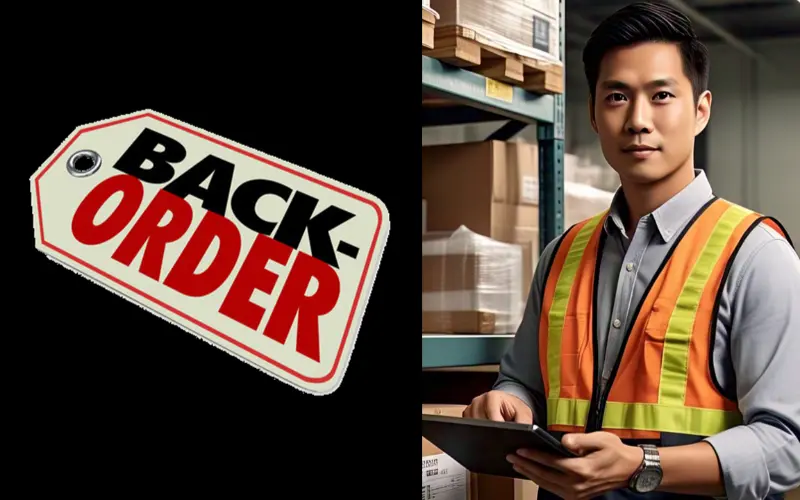
 11 minutes
11 minutes
